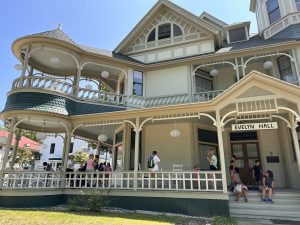
Northern Michigan Beaches
Summer’s not summer without a day at the beach and Northern Michigan offers some of the best beaches anywhere.
The Mackinac Bridge is the 10th largest suspension bridge (over water) in the world. It connects Michigan’s Upper and Lower Peninsula over the Straits of Mackinac, where Lake Michigan and Lake Huron meet. Mackinaw City is located at the southern point of the bridge, and St. Ignace at the northern point. I-75 is the highway that crosses the bridge. which starts from Sault Ste. Marie and ends north of Miami. The total length of the suspension bridge is 8,614 feet, with the total length of the bridge at five miles. Close to 500,000 vehicles cross the Mackinac Bridge during the summer. That number drops to around 169,000 in January. Annual vehicle crossing is approximately 4,000,000.
As far back as 1884, discussions were being held regarding the need for a bridge or tunnel between the Upper and Lower peninsulas. After the construction of the Brooklyn Bridge in 1883, interest grew for a suspension bridge of this type to span the Straits of Mackinac. The Board of Directors of the Grand Hotel on Mackinac Island reiterated the great need for a bridge to bring tourists to the island during the summer season.
Over the next 50 years, many ideas were presented, from a floating tunnel to a series of bridges and causeways from Cheboygan, around Bois Blanc and Round Islands, to Mackinac Island and finally St. Ignace.
Ferry service was started around 1923, but the traffic became so heavy that once again plans for a bridge were resurrected. In 1934, the Mackinac Straits Bridge Authority of Michigan was formed. During the next ten years, grants and loans were applied for, plans were drawn up, and a 4,200 foot causeway from St. Ignace was constructed. Then WWII began and all bridge progress came to a halt until 1947.
Finally in 1953, financing through a group of investment companies was the catalyst to finally begin the bridge project. Maintenance of the structure would be paid for from license plate and gasoline taxes. The great engineer Dr. David B. Steinman was hired for the design of the Mackinac Bridge and construction officially began in May of 1954.
After three years, the Mackinac Bridge was open to traffic on November 1, 1957. Total cost to build the bridge was $99,800,000. During construction five men lost their lives, and a monument in their honor was erected. In 1997, a bridge painter fell to his death, bringing the death toll to six.
Mackinac Bridge Authority
N. 415 I-75, St Ignace, MI, 49781
(906) 643-7600

Summer’s not summer without a day at the beach and Northern Michigan offers some of the best beaches anywhere.

Young State Park outside Boyne City is a ‘year round delight for campers, hikers, snow lovers, swimmers and nature lovers.

The Oden State Fish Hatchery in Alanson produces three strains of brown trout and one strain of rainbow trout.

Founded in 1875, Bay View in Petoskey is a National Historic Landmark community with community-owned buildings, cottages, and two inns.

The arts, history and many types of entertainment in Northern Michigan mean visitors can enjoy fabulous music, theatre, and culture.

Get off the ferry from Mackinaw City or St. Ignace to Mackinac Island and the first thing you’ll see is the historic downtown area.

With woods, dunes, and frozen lakes, the trails near Charlevoix and Boyne City are the places to cross country ski from December-March.

The Harsha House and the Charlevoix Depot Museum, run by the Charlevoix Historical Society, preserve much of Charlevoix’s rich history.

Disc golf is hot everywhere and especially in Northern Michigan because of it’s many courses and beautiful scenery.